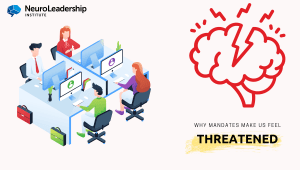
Your Brain On Goals
What does your brain look like on goals? What’s happening? How could the process be better?
Thank you for searching the NeuroLeadership Institute archives. Here’s what we were able to find for you.
Still having difficulty finding what you’re looking for? Contact us.

What does your brain look like on goals? What’s happening? How could the process be better?

As companies figure out how to implement vaccination mandates, brain science can help leaders develop strategies for managing employee reactions. Mandates feel like a violation of autonomy, which is one of the five most important intrinsic drivers of threat and reward in the brain. To help people feel less threatened, managers can try to offer another form of autonomy — for example, with the vaccine, this may mean allowing employees to choose when, where, or how they receive the shot. Another way to address the threat is to try to trigger one of the brain’s reward drivers. For example, the jarring nature of reduced autonomy (“Why am I mandated to do something?”) can be partially offset by increasing feelings of relatedness between employees (“I haven’t felt this close to my team in a while.”) Managers can also take steps to make employees feel greater levels of certainty, another of the brain’s reward drivers. While it’s difficult to provide absolute certainty when dealing with a mutating virus, transparency and communication can help provide clarity.
Join millions of employees in creating culture change at scale by reaching out today.

In 2007, David and Lisa Rock and their team had been working in leadership development and executive coaching for ten years, when David coined the term “NeuroLeadership.”ef

North America
Africa
South America
Asia
Europe
Australia
© NeuroLeadership Institute 2025. All Rights Reserved
This site uses cookies to provide you with a personalized browsing experience. By using this site you agree to our use of cookies as explained in our Privacy Policy. Please read our Privacy Policy for more information.